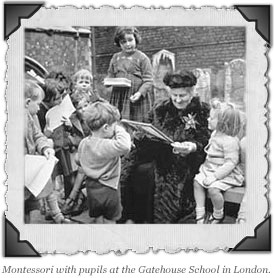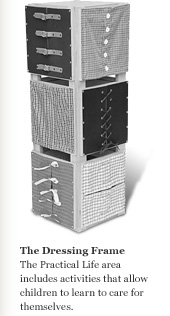 Maria Montessori
Maria Montessori
The Montessori method of education is named after its founder Dr. Maria Montessori (1870-1952), a pioneer in the area of child development and education. By working with and carefully observing young children, she brought about a new form of education and transformed the way we think about children.
Maria Montessori was actually Italy’s first female physician. In a psychiatric clinic in Rome, she worked with children in asylums for the insane. Her work with these “mentally defective” children was so effective that they were able to pass state examinations along with “normal” children. While others hailed her success, she wondered how education had failed the normal children. Why were they not more advanced than her mentally defective children?
Her chance to work with normal children came in 1907 when she began caring for about fifty children in a poor neighborhood in Rome. Her scientific training and keen sense of observation opened her eyes to the young child’s natural ability to effortlessly absorb knowledge and culture from his environment; she called this the period of the ‘absorbent mind’. She respected the children as individuals and gave them freedom within an environment specifically designed to meet their needs. This “prepared environment” allowed children to move about freely and choose from the many activities that would facilitate their development and their absorption of knowledge and culture. In effect, the children taught themselves through their exploration of the materials. The Montessori classroom allows for this interaction in a community where children of different ages work, play, learn and grow together, each at his or her own pace. In the mixed age grouping, the younger children often observe and learn from the older children while the older children, acting as leaders and mentors, give back to the community and solidify their knowledge by sharing it with the younger ones.
Montessori Materials
The Montessori materials are devised so that each has a “control of error” inherent in the activity. This allows the child to correct herself and make discoveries on her own. The Montessori materials fall into five major categories: Practical Life, Sensorial, Language, Math and Cultural.
The Practical Life area includes activities that allow children to learn to care for themselves and their environment using materials familiar to them. These activities also help children develop their small and large muscle coordination, concentration, independence, logic and aesthetic sense. In these exercises, the “doing” is more important than the end result.
Sensorial materials refine the senses and help children clarify and categorize the vast number of sensory impressions they have already received from the environment. The Sensorial materials are concrete, tangible examples of what they have experienced. For example: the red rods are ten rods that differ only in length; they range from ten centimeters to one hundred centimeters. Here the child concretely experiences the notion of length because the length is the only quality that varies. In Montessori’s words, she has “isolated the difficulty.”
Language materials provide for vocabulary enrichment, language training and the development of writing and reading. A child’s development of language is an important step for her on the road to independence. Language allows the child to express herself and to communicate with others; it helps her bring her previously unconscious experiences to the conscious level. Language also helps the child expand her mind for words and thoughts are the expressions of the mind.
The Math materials start with very concrete examples of number symbols and quantity. As the child progresses, the lessons increase in difficulty (odds & evens, teens, fractions, etc.) and become more and more abstract. The children are introduced to the Decimal System where they also learn the concepts of addition, subtraction, multiplication and division.
The Cultural area of the Montessori classroom consists of geography, history, art, music, science, cooking, gardening, lessons in grace and courtesy and any other opportunities that present themselves. By allowing the children to freely experience their environment we are aiding their natural ability to absorb knowledge and culture without effort.

